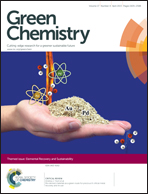Copper-catalyzed efficient synthesis of a 2-benzimidazolone scaffold from 2-nitroaniline and dimethyl carbonate via a hydrosilylation reaction†
Abstract
This work reports a copper-catalyzed novel protocol for the tandem synthesis of 2-benzimidazolone derivatives from dimethyl carbonate (DMC) and various 2-nitroanilines by using polymethylhydrosiloxane (PMHS) as an inexpensive, stable and environmentally benign reducing agent. This methodology is applicable for the preparation of a broad range of biologically active 2-benzimidazolone derivatives with a good scope in good to excellent yields.


 Please wait while we load your content...
Please wait while we load your content...